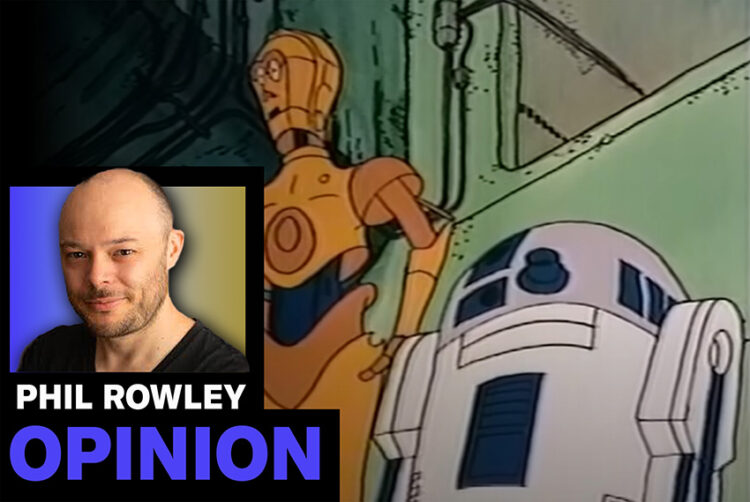Welcome to ‘perma-nostalgia’: How the digital age keeps our past alive and profitable

Opinion
Our pasts are now indexed like any other webpage. What does that do to the consumption of, and our appreciation of, media?
We are now living in an era when content never dies and cultural memories never fade.
Technology is enabling an age of digitised “perma-nostalgia”, when everything past and present is happening simultaneously.
In previous eras, dedicated collectors and conservationists would go the extra mile to curate, archive and preserve past media output, pickling it for enthusiasts to unearth years later.
Rare or forgotten media wasn’t invisible exactly, but could often be only found by those who knew where to look: perusing dusty bookshelves in provincial towns; flipping through stacks of vinyls in classic record shops; rooting through circular tins of film reel.
But now things are different.
Now art, films, books and games can be captured, stored and accessed electronically with little loss of fidelity. Algorithms can scan long-lost content and surface results instantly. We’ve moved from “rare finds” to “everything, everywhere, all at once”.
Not only is this having a profound effect on our culture, but it’s also impacting the way audiences consume their media.
Reliving the 1980s in the 2020s
Recently, just by using Google, YouTube and searching ecommerce sites, I managed to track down the following artefacts from own personal history.
The Ladybird Dinosaurs book, first published in 1974. I likely last read this while sitting in a pushchair. Now it’s across numerous second-hand book websites.
A fully playable internet version of Escape from Moonbase Alpha, originally on the Acorn Electron early computer and first released in 1983. Last time I played it, I loaded it off cassette tape and viewed it through a cathode-ray TV.
A full version of Ken Loach’s The Price of Coal, a seminal kitchen-sink TV comedy-drama about coal miners begrudgingly preparing for an official pit visit from Prince Charles. First shown in 1977 and before I was born, my dad opined that he would love to see it again. I went looking for it and found it on YouTube. To my mind, being from coal-mining stock myself, it is some of the greatest hours of television ever made.
In each of these cases, I went searching for content that, by rights, I would have been incredibly lucky to have ever seen again. But now our pasts are indexed like any other webpage. One search term later and we’re back in the 1980s, reliving our childhoods.
What does that do to the consumption of, and our appreciation of, media?
Three effects, I think.
‘Always up’ content
The first effect is that creators’ and makers’ efforts are permanent. This is both a blessing and a curse.
In past times, when linear TV ruled the airwaves, programmes had one airing and maybe a repeat. That was the window of opportunity for praise or opprobrium.
Now, content is “up” indefinitely and can be found and refound much later, building a new following if a cultural trigger suddenly makes it relevant. Running Up That Hill by Kate Bush, for instance, saw an 8,700% increase — that’s not a typo — in plays on Spotify thanks to its use in the finale of Stranger Things series four.
Alternatively, some things better left forgotten will remain front of mind forever.
In 1978, in between the release of A New Hope and The Empire Strikes Back, George Lucas made the TV spin-off extravaganza Star Wars Holiday Special, but was so unhappy with it that he tried to get every copy destroyed.
Yet here it is on the internet decades later. A YouTube comment states: “If it weren’t for the internet, I may have gone the rest of my life thinking the memory of this was just an early childhood hallucination.”
For creators, the internet’s “foreverness” could be a route to late-blossoming stardom or a permanent black mark.
For media owners, however, there’s something else: a real revenue opportunity.
The monetisation of nostalgia
Second, this flattening of time means we see an ever-increasing chance to profit from the past.
Admittedly, nostalgia is nothing new. We’ve always wallowed in times gone by. Films about World War II were a constant across the 1960s, 1970s and 1980s. Britpop was a reheated Swinging 60s. ITV3 and UK Gold’s business model is based on showing old episodes of Inspector Morse and Keeping Up Appearances. In 2001, Channel 4 had “The 80s Night”, when they showed complete back-to-back programme schedules, including ad breaks.
More recently, the BBC uploaded every single episode of Doctor Who on iPlayer, meaning I could get a second viewing of the Tom Baker episodes that terrified me as a child but that in 2024 made me laugh out loud.
As we excavate and preserve more and more moments from our past, we will see an exponential increase in those nostalgic access points.
And, in turn, that means yet more business models built on converting archives into ammunition, libraries into lucre and reminiscing into revenue.
In practice, expect to see more channels dedicated to classic content. The rise of free ad-supported TV channels — internet-only broadcasters that can endlessly loop episodes of Only Fools and Horses or Poirot — can get nerdier and more granular with the content they resurrect. An endless loop of ThunderCats, maybe? The Knight Rider channel? The entire back catalogue of The Antiques Roadshow — which itself is a compendium of times past?
This also means advertisers can start to locate audiences with greater precision. For example, a hardware store can get even more targeted with their messaging, knowing a cohort with a hankering for old episodes of Homes Under The Hammer will always be found in one place.
Thus, “let bygones be bygones” has now become “a bygone is for life, not just for Christmas”. The past co-exists with the present. Because it’s good business.
Culture as a living library
Last, as well as media providing a permanent record ripe for reuse, it may also mean our cultural output is more of a melting pot. Not from a diversity of international sources — although globalisation also makes that true — but from a diversity of chronological sources.
Rather than viewing culture as a linear progression, we may come to see it as a flattened map, where all influences are equally accessible from all points. New creators can take their cues from themes from past eras so much more easily, driving the rise of chronologically hybridised genres.
Take the band Sleep Token, who ratify this effect by cross-pollinating influences from across the ages in their music. Their breakthrough hit Take Me Back to Eden references death metal and prog rock, but also R&B and hip-hop. Listening to it is like a bruising rocket-sledge ride through the history of 1980s, 1990s and 2000s music. Anyone enjoying the gentle pop intro will get the fright of their life by the screamingly hellish outro. It’s all genres and no genre, all at once.
In turn, this may also impact how generations understand each other. Younger audiences, for instance, may gravitate towards music from times past without even noticing they are listening to a “classic”. If Spotify’s algorithm continues to package together the old and the new because it sees granular similarity in beats per minute or lyrics or guitar effects, these chronologically disparate styles become part of a cross-generational genre blur.
Again, while older creative output has always crossed timelines to trigger and provoke new creators, modern tech is now ensuring that the bridges between eras are sturdy and numerous, and that traffic flows across them fast and unimpeded.
No need to dig for inspiration. It’s on the surface, all the time.
The past as a toolkit
Thus, we may soon realise that digitisation becomes responsible not only for archiving our artistry but also making our culture more organic by continually reintegrating past references into the present. The past is a toolkit, better preserved than ever, from which we can access more solutions to our creative challenges.
In the business of broadcasting, media and advertising, that means more opportunities to plug into people’s passion points from the present but also the past. Nostalgia and a yearning for times gone by can be a powerful emotional “homing beacon” and a place where consumers can be found in a reflective, wistful state of mind.
If the past is where some of us want to be, then that’s a need state that should be answered. This presents a massive opportunity precisely because there’s always more of the past than the present. Because that’s how time works.
 Phil Rowley is head of futures at Omnicom Media Group UK and author of Hit the Switch: The Future of Sustainable Business. He writes a monthly column for The Media Leader about the future of media
Phil Rowley is head of futures at Omnicom Media Group UK and author of Hit the Switch: The Future of Sustainable Business. He writes a monthly column for The Media Leader about the future of media




